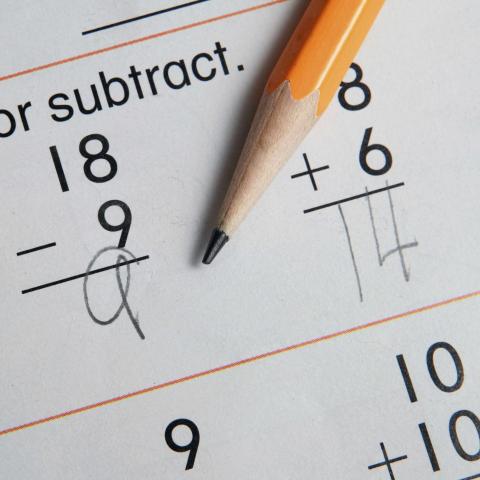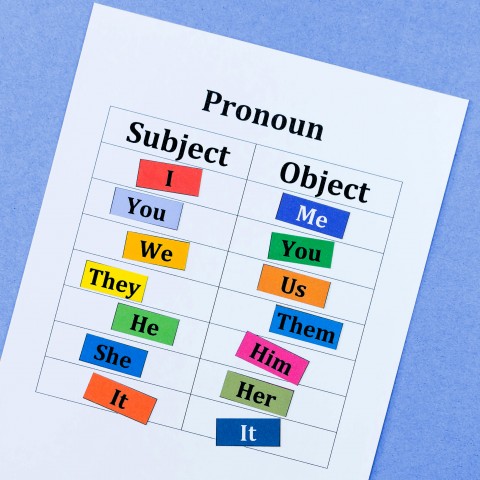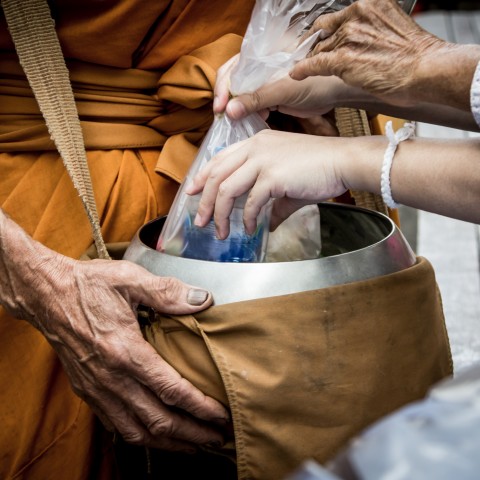
Have you been learning Thai for a while and want to continue expanding your knowledge? If you already feel comfortable using the language at an intermediate level, it’s time to press onward and start learning advanced Thai vocabulary. Picking up more sophisticated words and terms will enable you to understand more complex conversations and communicate more like a native speaker.
To help you start strong, we have prepared this practical list of advanced Thai vocabulary words. For each word, we have included:
- English translation
- Part of speech
- Example(s) of use
At ThaiPod101.com, it’s our goal to make learning Thai easy and fun! Keep reading to become acquainted with the most important advanced words in the Thai language.
 Table of Contents
Table of Contents
- Advanced Academic Words
- Advanced Business Words
- Advanced Medical Words
- Advanced Legal Words
- Alternative Words for More Sophisticated Writing & Speech
- Conclusion
1. Advanced Academic Words
Do you plan to study in Thailand? Learning these advanced Thai words for essays, thesis papers, and academic reading will help you thrive and flourish in any Thai school!
1 – วิทยานิพนธ์
Pronunciation: wít-thá-yaa-ní-phon
English meaning: thesis
Part of speech: noun
Example:
เธอทำวิทยานิพนธ์เสร็จหรือยัง
thooe-tham-wít-thá-yaa-ní-phon-sèt-rǔue-yang
Have you finished your thesis?
2 – คำนำ / บทนำ
Pronunciation: kham-nam / bòt-nam
English meaning: introduction
Part of speech: noun
Example 1:
คำนำไม่ควรยาวเกิน 1 หน้านะ
kham-nam-mâi-khuuan-yaao-gooen-nùeng-nâa-ná
The introduction shouldn’t be longer than one page.
Example 2:
บทนำไม่ควรยาวเกิน 1 หน้านะ
bòt-nam-mâi-khuuan-yaao-gooen-nùeng-nâa-ná
The introduction shouldn’t be longer than one page.
3 – สารบัญ
Pronunciation: sǎa-rá-ban
English meaning: table of contents
Part of speech: noun
Example:
ฉันลืมพิมพ์สารบัญ
chǎn-luuem-phim-sǎa-rá-ban
I forgot to print the table of contents.
4 – วิจัย
Pronunciation: wí-jai
English meaning: research
Part of speech: verb
Example:
เธอยังไม่เริ่มทำวิจัยอีกเหรอ แล้วจะทำวิทยานิพนธ์เสร็จทันมั้ย
thooe-yang-mâi-rôoem-tham-wí-jai-ìik-rǒoe láaeo-jà-tham-wít-thá-yaa-ní-phon-sèt-than-mái
You haven’t even started research? Will you be able to finish the thesis in time?
5 – ความเป็นมาและความสำคัญของปัญหา
Pronunciation: khwaam-bpen-maa-láe-khwaam-sǎm-khan-khǎawng-bpan-hǎa
English meaning: problem statement
Part of speech: noun
Example:
เวลาเริ่มทำวิทยานิพนธ์ ต้องเริ่มจากการเขียนความเป็นมาและความสำคัญของปัญหา
wee-laa-rôoem-tham-wít-thá-yaa-ní-phon dtâawng-rôoem-jàak-gaan-khǐian-khwaam-bpen-maa-láe-khwaam-sǎm-khan-khǎawng-bpan-hǎa
When doing a thesis, you should start with a problem statement.
6 – วัตถุประสงค์ / เป้าหมาย
Pronunciation: wát-thù-bprà-sǒng / bpâo-mǎai
English meaning: objective
Part of speech: noun
Example 1:
วัตถุประสงค์ในการทำวิจัยนี้คืออะไร
wát-thù-bprà-sǒng-nai-gaan-tham-wí-jai-níi-khuue-à-rai
What is the objective of this research?
Example 2:
เป้าหมายในการทำวิจัยนี้คืออะไร
bpâo-mǎai-nai-gaan-tham-wí-jai-níi-khuue-à-rai
What is the objective of this research?
Additional note:
วัตถุประสงค์ sounds more formal than เป้าหมาย.
7 – การทบทวนวรรณกรรม
Pronunciation: gaan-thóp-thuuan-wan-ná-gam
English meaning: literature review
Part of speech: noun
Example:
ฉันทำการทบทวนวรรณกรรมไม่เป็น เธอสอนฉันหน่อยได้มั้ย
chǎn-tham-gaan-thóp-thuuan-wan-ná-gam-mâi-bpen thooe-sǎawn-chǎn-nàuuy-dâi-mâi
I don’t know how to do a literature review. Can you teach me?
8 – คำนิยาม
Pronunciation: kham-ní-yaam
English meaning: definition
Part of speech: noun
Example:
คำนิยามของคำนี้คืออะไร
kham-ní-yaam-khǎawng-kham-níi-khuue-à-rai
What is the definition of this word?
9 – คำอธิบาย
Pronunciation: kham-à-thí-baai
English meaning: explanation
Part of speech: noun
Example:
อย่าลืมเขียนคำอธิบายไว้ท้ายรายงานด้วยนะ
yàa-luuem-khǐian-kham-à-thí-baai-wái-tháai-raai-ngaan-dûuay-ná
Don’t forget to write an explanation at the end of the report.
10 – วิธีดำเนินการทำวิจัย
Pronunciation: wí-thii-dam-nooen-gaan-tham-wí-jai
English meaning: research methodology
Part of speech: noun
Example:
คุณน่าจะขอคำแนะนำเกี่ยวกับวิธีดำเนินการทำวิจัยจากอาจารย์นะ
khun-nâa-jà-khǎaw-kham-náe-nam-gìiao-gàp-wí-thii-dam-nooen-gaan-tham-wí-jai-jàak-aa-jaan-ná
You should ask for advice about research methodology from your teacher.
11 – การเก็บรวบรวมข้อมูล
Pronunciation: gaan-gèb-rûuap-ruuam-khâaw-muun
English meaning: sample and data collection
Part of speech: noun
Example:
ฉันใช้เวลา 3 เดือนในการเก็บรวบรวมข้อมูล
chǎn-chái-wee-laa-sǎam-duuean-nai-gaan-gèb-rûuap-ruuam-khâaw-muun
I spent three months on sample and data collection.
12 – ผลวิเคราะห์ข้อมูล
Pronunciation: phǒn-wí-khráw-khâaw-muun
English meaning: data analysis
Part of speech: noun
Example:
ฉันจะได้ผลวิเคราะห์ข้อมูลเมื่อไหร่
chǎn-jà-dâi-phǒn-wí-khráw-khâaw-muun-mûuea-rài
When will I get the data analysis?
13 – บทสรุป
Pronunciation: bòt-sà-rùp
English meaning: conclusion
Part of speech: noun
Example:
บทสรุปของเธอดีมาก
bòt-sà-rùp-khǎawng-thooe-dii-mâak
Your conclusion is very good.
14 – อภิปราย
Pronunciation: à-phí-bpraai
English meaning: to discuss
Part of speech: verb
Example:
มาอภิปรายประเด็นนี้อีกครั้งเถอะ
maa-à-phí-bpraai-bprà-den-níi-ìik-khráng-thòe
Let’s discuss this topic again.
15 – ข้อเสนอแนะ
Pronunciation: khâaw-sà-nǒoe-náe
English meaning: suggestion
Part of speech: noun
Example:
เธอควรจะเขียนข้อเสนอแนะซัก 2-3 ข้อนะ
thooe-khuuan-ja-khǐian-khâaw-sà-nǒoe-náe-sák-sǎawng-sǎam-khâaw-ná
You should write a few suggestions.
16 – ดัชนี
Pronunciation: dàt-chá-nii
English meaning: index
Part of speech: noun
Example:
ปกติแล้ว ดัชนีจะอยู่ส่วนท้ายของรายงาน
bpòk-gà-dtì-láaeo dàt-chá-nii-jà-yùu-sùuan-tháai-khǎawng-raai-ngaan
Normally, the index is put at the end of the report.
17 – อ้างอิง
Pronunciation: âang-ing
English meaning: to cite
Part of speech: verb
Example:
อย่าลืมอ้างอิงที่มาที่ไปของข้อมูลนะ
yàa-luuem-âang-ing-thîi-maa-thîi-bpai-khǎawng-khâaw-muun-ná
Don’t forget to cite the source of information.
18 – สมมติฐาน
Pronunciation: sǒm-mút-dtì-thǎan
English meaning: assumption
Part of speech: noun
Example:
เธอตั้งสมมุติฐานไว้ว่ายังไง
thooe-dtâng-sǒm-mút-dtì-thǎan-wái-wâa-yang-ngai
What is your assumption?
19 – เชิงอรรถ
Pronunciation: chooeng-àt
English meaning: footnote
Part of speech: noun
Example:
เชิงอรรถคืออะไร
chooeng-àt-khuue-à-rai
What is the footnote?
20 – ทฤษฎี
Pronunciation: thrít-sà-dii
English meaning: theory
Part of speech: noun
Example:
ฉันไม่เข้าใจทฤษฎีนี้เลยซักนิดเดียว มันยากมาก
chǎn-mâi-khâo-jai-thrít-sà-dii-níi-looei-sák-nít-diiao man-yâak-mâak
I don’t understand a thing about this theory. It is extremely difficult.
21 – การประเมิน
Pronunciation: gaan-bprà-mooen
English meaning: assessment
Part of speech: noun
Example:
ลดาไม่ผ่านการประเมิน
lá-daa-mâi-phàan-gaan-bprà-mooen
Lada did not pass the assessment.
22 – การโต้วาที
Pronunciation: gaan-dtôo-waa-thii
English meaning: debate
Part of speech: noun
Example:
การโต้วาทีหัวข้อนี้น่าสนใจมาก
gaan-dtôo-waa-thii-hǔua-khâaw-níi-nâa-sǒn-jai-mâak
The topic of this debate is very interesting.

23 – เกณฑ์การประเมิน
Pronunciation: geen-gaan-bprà-mooen
English meaning: evaluation criteria
Part of speech: noun
Example:
อย่าลืมดูเกณฑ์การประเมินนะ
yàa-luuem-duu-geen-gaan-bprà-mooen-ná
Don’t forget to look at the evaluation criteria.
2. Advanced Business Words
For those who are doing business in Thailand, knowing these advanced Thai vocabulary words will make all the difference in your day-to-day communications. We have included terminology related to companies, policies, and the business world, as well as words you could use in the workplace.
1 – กรรมการ
Pronunciation: gam-má-gaan
English meaning: director
Part of speech: noun
Example:
บริษัทนี้มีกรรมการ 5 คน
baaw-rí-sàt-níi-mii-gam-má-gaan-hâa-khon
There are five directors in this company.
2 – ที่ปรึกษา
Pronunciation: thîi-bprùk-sǎa
English meaning: consultant
Part of speech: noun
Example:
คุณมินตราเป็นที่ปรึกษาของบริษัทเรา
khun-min-dtraa-bpen-thîi-bprùk-sǎa-khǎawng-baaw-rí-sàt-rao
Mintra is our company’s consultant.
3 – ผู้จัดการ
Pronunciation: phûu-jàt-gaan
English meaning: manager
Part of speech: noun
Example:
ผู้จัดการเพิ่งลาออกจากบริษัทไป
phûu-jàt-gaan-phôoeng-laa-àawk-jàak-baaw-rí-sàt-bpai
The manager just resigned from our company.
4 – รองผู้จัดการ
Pronunciation: raawng-phûu-jàt-gaan
English meaning: assistant manager
Part of speech: noun
Example:
รองผู้จัดการได้เลื่อนตำแหน่งเป็นผู้จัดการเดือนที่แล้ว
raawng-phûu-jàt-gaan-dâi-lûuean-dtam-nàaeng-bpen-phûu-jàt-gaan-dooen-thîi-láaeo
The assistant manager was just promoted to manager last month.
5 – ผู้ถือหุ้น
Pronunciation: phûu-thǔue-hûn
English meaning: shareholder
Part of speech: noun
Example:
เมื่อวานนี้มีประชุมผู้ถือหุ้น
mûuea-waan-níi-mii-bprà-chum-phûu-thǔue-hûn
There was a shareholder meeting yesterday.
6 – ตลาดหุ้น
Pronunciation: dtà-làat-hûn
English meaning: stock market
Part of speech: noun
Example:
ตลาดหุ้นตกสัปดาห์ที่แล้ว
dtà-làat-hûn-dtòk-sàp-daa-thîi-láaeo
The stock market crashed last week.
7 – กำไร
Pronunciation: gam-rai
English meaning: profit
Part of speech: noun
Example:
ปีนี้กำไรของบริษัทเพิ่มขึ้น
bpii-níi-gam-rai-khǎawng-baaw-rí-sàt-phôoem-khûen
The company’s profit increased this year.

The company’s profit increased this year.
8 – ขาดทุน
Pronunciation: khàat-thun
English meaning: loss
Part of speech: noun
Example:
ธุรกิจของเธอไม่ค่อยดี ดูเหมือนว่าจะขาดทุน
thú-rá-gìt-khǎawng-thooe-mâi-khâauy-dii duu-mǔuean-wâa-jà-khàat-thun
Her business doesn’t look so good. It seems like a loss.
9 – เงินปันผล
Pronunciation: ngoen-bpan-phǒn
English meaning: dividend
Part of speech: noun
Example:
กองทุนนี้จ่ายเงินปันผลดีมาก
gaawng-thun-níi-jàai-ngoen-bpan-phǒn-dii-mâak
The dividend of this fund is very good.
10 – ผลตอบแทน
Pronunciation: phǒn-dtàawp-thaaen
English meaning: return on investment
Part of speech: noun
Example:
ทุกคนอยากได้ผลตอบแทนมาก ๆ จากการลงทุน
thúk-khon-yàak-dâi-phǒn-dtàawp-thaaen-mâak-mâak-jàak-gaan-long-thun
Everyone wants a high return on investment.
11 – กองทุน
Pronunciation: gaawng-thun
English meaning: fund
Part of speech: noun
Example:
กองทุนนี้มีผลการดำเนินงานดี
gaawng-thun-níi-mii-phǒn-gaan-dam-nooen-ngaan-dii
This fund has a good performance.
12 – รายได้
Pronunciation: raai-dâi
English meaning: revenue
Part of speech: noun
Example:
ผมอยากได้รายงานรายได้ของเดือนนี้
phǒm-yàak-dâi-raai-ngaan-raai-dâi-khǎawng-duuean-níi
I want a revenue report for this month.
13 – ค่าใช้จ่าย
Pronunciation: khâa-chái-jàai
English meaning: expense
Part of speech: noun
Example:
ค่าใช้จ่ายในการซ่อมบำรุงสูงมาก
khâa-chái-jàai-nai-gaan-sâawm-bam-rung-sǔung-mâak
The maintenance expense is really high.
14 – ภาษี
Pronunciation: phaa-sǐi
English meaning: tax
Part of speech: noun
Example:
ภาษีมูลค่าเพิ่มในประเทศไทยคือเท่าไหร่
phaa-sǐi-muun-lá-khâa-phôoem-nai-bprà-thêet-thai-khuue-thâo-rài
What is the rate of value-add tax in Thailand?
15 – ล้มละลาย
Pronunciation: lóm-lá-laai
English meaning: bankrupt
Part of speech: verb
Example:
เขาเครียดมาก เพราะบริษัทของเขากำลังจะล้มละลาย
khǎo-khrîiat-mâak phráw-baaw-rí-sàt-khǎawng-khǎo-gam-lang-jà-lóm-lá-laai
He is so stressed because his company is about to go bankrupt.
16 – สวัสดิการ
Pronunciation: sà-wàt-dì-gaan
English meaning: welfare
Part of speech: noun
Example:
สวัสดิการของบริษัทนี้ดีมาก
sà-wàt-dì-gaan-khǎawng-baaw-rí-sàt-níi-dii-mâak
The welfare of this company is really good.
17 – ชดเชย
Pronunciation: chót-chooei
English meaning: compensate
Part of speech: verb
Example:
คุณจะชดเชยต่อความเสียหายนี้เท่าไหร่
khun-jà-chót-chooei-dtàaw-khwaam-sǐia-hǎai-níi-thâo-rài
How much will you compensate for this damage?
18 – การจ้างงาน
Pronunciation: gaan-jâang-ngaan
English meaning: employment
Part of speech: noun
Example:
การจ้างงานของบริษัทปีที่แล้วลดลง
gaan-jâang-ngaan-khǎawng-baaw-rí-sàt-bpii-thîi-láaeo-lót-long
The company’s employment rate decreased last year.
19 – สำนักงานใหญ่
Pronunciation: sǎm-nák-ngaan-yài
English meaning: head office
Part of speech: noun
Example:
สำนักงานใหญ่ของบริษัทนี้อยู่ที่ไหน
sǎm-nák-ngaan-yài-khǎawng-baaw-rí-sàt-níi-yùu-thîi-nǎi
Where is this company’s head office?
20 – สาขา
Pronunciation: sǎ-khǎa
English meaning: branch
Part of speech: noun
Example:
สาขาที่ใกล้ที่สุดอยู่ที่สีลม
sǎ-khǎa-thîi-glâi-thîi-sùt-yùu-thîi-sǐi-lom
The closest branch is at Silom.
21 – นโยบาย
Pronunciation: ná-yoo-baai
English meaning: policy
Part of speech: noun
Example:
ขอทราบนโยบายการเปลี่ยนคืนสินค้า
khǎaw-sâap-ná-yoo-baai-gaan-bplìian-khuuen-sǐn-kháa
Please tell me about the return policy.
22 – เอสเอ็มอี
Pronunciation: éet-em-ii
English meaning: SME (stands for “small and medium enterprises”)
Part of speech: noun
Example:
ธุรกิจของบ้านฉันเป็นธุรกิจเอสเอ็มอี
thú-rá-gìt-khǎawng-bâan-chǎn-bpen-thú-rá-gìt-éet-em-ii
My family business is an SME.
23 – ธุรกิจ
Pronunciation: thú-rá-gìt
English meaning: business
Part of speech: noun
Example:
เธอกำลังทำธุรกิจใหม่
thooe-gam-lang-tham-thú-rá-gìt-mài
She is starting a new business.
24 – ใบเสร็จ
Pronunciation: bai-sèt
English meaning: receipt
Part of speech: noun
Example:
ฉันทำใบเสร็จหาย
chǎn-tham-bai-sèt-hǎai
I lost the receipt.
25 – ใบกำกับภาษี
Pronunciation: bai-gam-gàp-phaa-sǐi
English meaning: tax invoice
Part of speech: noun
Example:
เธอต้องขอใบกำกับภาษีเพื่อยื่นให้แผนกบัญชี
thooe-dtâawng-khǎaw-bai-gam-gàp-phaa-sǐi-phûuea-yûuen-hâi-phà-nàaek-ban-chii
You need to ask for the tax invoice to give to the accounting department.
3. Advanced Medical Words
Being sick is an unavoidable part of life. Learning advanced vocabulary words in Thai related to medical treatment will help you explain your symptoms, understand what doctors or nurses are telling you, and maybe even give you a leg up if you plan to enter the medical field in Thailand.
1 – การรักษา
Pronunciation: gaan-rák-sǎa
English meaning: treatment
Part of speech: noun
Example:
การรักษาอาการท้องผูกมีหลายวิธี
gaan-rák-sǎa-aa-gaan-tháawng-phùuk-mii-lǎai-wí-thii
There are many treatments for constipation.
2 – ฉีดยา
Pronunciation: chìit-yaa
English meaning: to inject
Part of speech: verb
Example:
เด็กร้องไห้ เพราะ ถูกฉีดยา
dèk-ráawng-hâi-phráw-thùuk-chìit-yaa
The child cried because he was injected.
3 – ฉีดวัคซีน
Pronunciation: chìit-wák-siin
English meaning: to vaccinate
Part of speech: verb
Example:
ฉันฉีดวัคซีนไข้หวัดใหญ่ทุกปี
chǎn-chìit-wák-siin-khâi-wàt-yài-thúk-bpii
I have been vaccinated for influenza every year.
4 – ผ่าตัด
Pronunciation: phàa-dtàt
English meaning: to operate
Part of speech: verb
Example:
พ่อเคยผ่าตัดเพื่อรักษาโรคนิ่ว
phâaw-khooei-phàa-dtàt-phûuea-rák-sǎa-rôok-nìu
Dad was operated on to treat his gallstones.
5 – เข้าเฝือก
Pronunciation: khâo-fùueak
English meaning: to splint
Part of speech: verb
Example:
น้องสาวเคยเข้าเฝือกเพื่อรักษาอาการแขนหัก
náawng-sǎao-khooei-khâo-fùueak-phûuea-rák-sǎa-aa-gaan-khǎaen-hàk
My sister was splinted to treat her broken arm.
6 – ตรวจชิ้นเนื้อ
Pronunciation: dtrùuat-chín-núuea
English meaning: biopsy
Part of speech: noun
Example:
เธอถูกตรวจชิ้นเนื้อที่ปอด
thooe-thùuk-dtrùuat-chín-núuea-thîi-bpàawt
She had a lung biopsy.
7 – ยา
Pronunciation: yaa
English meaning: medicine
Part of speech: noun
Example:
อย่าลืมกินยานะ
yàa-luuem-gin-yaa-ná
Don’t forget to take the medicine.
8 – ยาชา
Pronunciation: yaa-chaa
English meaning: anesthetic
Part of speech: noun
Example:
คุณหมอทายาชาให้ก่อนทำแผล
khun-mǎaw-thaa-yaa-chaa-hâi-gàawn-tham-phlǎae
The doctor applied an anesthetic before treating the wound.
9 – เจาะเลือด
Pronunciation: jàw-lûueat
English meaning: to draw blood
Part of speech: verb
Example:
ฉันไม่อยากเจาะเลือดเลย
chǎn-mâi-yàak-jàw-lûueat-looei
I don’t want my blood to be drawn.
10 – เอกซเรย์
Pronunciation: ék-sá-ree
English meaning: X-ray
Part of speech: noun
Example:
คุณยายกำลังจะเอกซเรย์ปอด
khun-yaai-gam-lang-jà-ék-sá-ree-bpàawt
Grandma is about to get a lung X-ray.
11 – ซีทีแสกน
Pronunciation: sii-thii-sà-gaaen
English meaning: CT scan
Part of speech: noun
Example:
หมอสั่งให้ทำซีทีแสกน
mǎaw-sàng-hâi-tham-sii-thii-sà-gaaen
The doctor ordered a CT scan.
12 – วัดความดัน
Pronunciation: wát-khwaam-dan
English meaning: to measure blood pressure
Part of speech: verb
Example:
คุณวัดความดันแล้วหรือยัง
khun-wát-khwaam-dan-láaeo-rǔue-yang
Have you measured the blood pressure yet?
13 – วัดไข้
Pronunciation: wát-khâi
English meaning: to measure body temperature
Part of speech: verb
Example:
แม่เพิ่งวัดไข้เมื่อกี๊
mâae-pôoeng-wát-khâi-mûuea-gíi
Mom just measured her body temperature.
14 – ตรวจสุขภาพ
Pronunciation: dtrùuat-sùk-khà-phâap
English meaning: health check-up
Part of speech: noun
Example:
เธอควรตรวจสุขภาพปีละครั้ง
thooe-khuuan-dtrùuat-sùk-khà-phâap-bpii-lá-khráng
You should do a health check-up once a year.
15 – หาหมอ
Pronunciation: hǎa-mǎaw
English meaning: to go see the doctor
Part of speech: verb
Example:
ฉันรู้สึกไม่ค่อยดี พรุ่งนี้ฉันจะไปหาหมอ
chǎn-rúu-sùek-mâi-khâauy-dii phrûng-níi-chǎn-jà-bpai-hǎa-mǎaw
I’m not feeling very well. I will go see a doctor tomorrow.
16 – ปวดหัว
Pronunciation: bpùuat-hǔua
English meaning: to have a headache
Part of speech: verb
Example:
คุณตาปวดหัวรึเปล่า ตาดูไม่ค่อยดีเลย
khun-dtaa-bpùuat-hǔua-rúe-bplàao dtaa-duu-mâi-khâauy-dii-looei
[talking to Grandpa] Do you have a headache? You don’t look so well.
17 – ปวดท้อง
Pronunciation: bpùuat-tháawng
English meaning: to have a stomachache
Part of speech: verb
Example:
เมื่อวานฉันกินอาหารไม่สะอาด วันนี้เลยปวดท้อง
mûuea-waan-chǎn-gin-aa-hǎan-mâi-sà-àat wan-níi-looei-bpùuat-tháawng
Yesterday, the food I ate wasn’t very clean. Today, I have a stomachache.

18 – ปวดหลัง
Pronunciation: bpùuat-lǎng
English meaning: to have a backache
Part of speech: verb
Example:
เธอนั่งทำงานทั้งวัน ไม่ได้ออกกำลังกาย ก็เลยปวดหลัง
thooe-nâng-tham-ngaan-tháng-wan mâi-dâi-àawk-gam-lang-gaai gâaw-looei-bpùuat-lǎng
She sits and works all day, and doesn’t exercise. So, she has a backache.
19 – ชัก
Pronunciation: chák
English meaning: to convulse
Part of speech: verb
Example:
เธอเคยเห็นคนชักมั้ย
thooe-khooei-hěn-khon-chák-mái
Have you ever seen anybody convulse?
20 – ข้อเท้าพลิก
Pronunciation: khâaw-tháo-plík
English meaning: sprained ankle
Part of speech: noun
Example:
เมื่อวานฉันข้อเท้าพลิก เจ็บมาก
mûuea-waan-chǎn-khâaw-tháo-plík jèp-mâak
I had a sprained ankle yesterday. It hurts.
21 – เจ็บ
Pronunciation: jèp
English meaning: hurt
Part of speech: adjective
Example:
เจ็บมากมั้ย
jèp-mâak-mái
Are you hurt badly?
22 – ไข้ขึ้น
Pronunciation: khâi-khûen
English meaning: to have a fever
Part of speech: verb
Example:
เธอไข้ขึ้นสูงมาก
thooe-khâi-khûen-sǔung-mâak
She has a very high fever.
23 – ผื่น
Pronunciation: phùuen
English meaning: rash
Part of speech: noun
Example:
เขามีผื่นที่แขน
khǎo-mii-phùuen-thîi-khǎaen
He has a rash on his arm.
24 – เบื่ออาหาร
Pronunciation: bùuea-aa-hǎan
English meaning: to lose one’s appetite
Part of speech: verb
Example:
คุณยายรู้สึกเบื่ออาหาร
khun-yaai-rúu-sùek-bùuea-aa-hǎan
Grandma lost her appetite.
25 – เป็นลม
Pronunciation: bpen-lom
English meaning: to faint
Part of speech: verb
Example:
อากาศร้อนมากเลยจนเพื่อนของฉันเป็นลม
aa-gàat-ráawn-mâak-looei-jon-phûuean-khǎawng-chǎn-bpen-lom
The weather is so hot that my friend fainted.
26 – เวียนหัว
Pronunciation: wiian-hǔua
English meaning: dizzy
Part of speech: adjective
Example:
ตอนคุณแม่ท้อง คุณแม่เวียนหัวทุกเช้า
dtaaw-khun-mâae-tháawng khun-mâae-wiian-hǔua-thúk-cháo
While my mother was pregnant, she felt dizzy every morning.
27 – คัดจมูก
Pronunciation: khát-jà-mùuk
English meaning: to have nasal congestion
Part of speech: verb
Example:
ฉันรู้สึกคัดจมูก ฉันหายใจไม่ค่อยออก
chǎn-rúu-sùuek-khát-jà-mùuk chǎn-hǎai-jai-mâi-khâauy-àawk
I have nasal congestion. I can’t breathe well.
28 – จาม
Pronunciation: jaam
English meaning: to sneeze
Part of speech: verb
Example:
ฉันจามไม่หยุดมาตั้งแต่เมื่อวาน
chǎn-jaam-mâi-yùt-maa-dtâng-dtàae-mûuea-waan
I have been sneezing non-stop since yesterday.
29 – น้ำมูกไหล
Pronunciation: nám-mûuk-lǎi
English meaning: to have a runny nose
Part of speech: verb
Example:
แม่น้ำมูกไหล อาจจะเป็นหวัด
mâae-nám-mûuk-lǎi àat-jà-bpen-wàt
Mom has a runny nose. She may have a cold.
30 – ไอ
Pronunciation: ai
English meaning: to cough
Part of speech: verb
Example:
ผานิตไอจนรู้สึกเจ็บคอ
phǎa-nít-ai-jon-rúu-sùek-jèp-khaaw
Panit coughed until she had a sore throat.
31 – เจ็บคอ
Pronunciation: jèp-khaaw
English meaning: to have a sore throat
Part of speech: verb
Example:
คุณรู้สึกเจ็บคอรึเปล่า
khun-rúu-sùek-jèp-khaaw-rúe-bplàao
Do you have a sore throat?
4. Advanced Legal Words
Another set of advanced-level Thai words you should start learning are those related to the legal system in Thailand. Learning this terminology will help you have more complex conversations, avoid unfortunate misunderstandings, and more effectively study law if that’s where your path takes you!
1 – กฎหมาย
Pronunciation: gòt-mǎai
English meaning: law
Part of speech: noun
Example:
หนังสือเล่มนี้เกี่ยวกับกฎหมาย
nǎng-sǔue-lêem-níi-gìiao-gàp-gòt-mǎai
This book is about the law.
2 – รัฐธรรมนูญ
Pronunciation: rát-thà-tham-má-nuun
English meaning: constitution
Part of speech: noun
Example:
รัฐธรรมนูญเป็นหนึ่งในกฎหมายที่สำคัญ
rát-thà-tham-má-nuun-bpen-gòt-mǎai-thîi-sǎm-khan
The Constitution is an important law.
3 – ผู้พิพากษา
Pronunciation: phûu-phí-phâak-sǎa
English meaning: judge
Part of speech: noun
Example:
เพื่อนของฉันเป็นผู้พิพากษา
phûuean-khǎawng-chǎn-bpen-phûu-phí-phâak-sǎa
My friend is a judge.

My friend is a judge.
4 – ทนายความ
Pronunciation: thá-naai-khwaam
English meaning: lawyer
Part of speech: noun
Example:
ฉันอยากเป็นทนายความในอนาคต
chǎn-yàak-bpen-thá-naai-khwaam-nai-à-naa-khót
I want to be a lawyer in the future.
5 – อัยการ
Pronunciation: ai-yá-gaan
English meaning: prosecutor
Part of speech: noun
Example:
อัยการทำหน้าที่อะไร
ai-yá-gaan-tham-nâa-thîi-à-rai
What is the duty of the prosecutor?
6 – โจทก์
Pronunciation: jòot
English meaning: plaintiff
Part of speech: noun
Example:
ใครคือโจทก์ของคดีนี้
khrai-khuue-jòot-khǎawng-khá-dii-níi
Who is the plaintiff of this case?
7 – จำเลย
Pronunciation: jam-looei
English meaning: defendant
Part of speech: noun
Example:
จำเลยของคดีนี้เป็นคนมีชื่อเสียง
jam-looei-khǎawng-khá-dii-níi-bpen-khon-mii-chûue-sǐiang
The defendant of this case is a famous person.
8 – พยาน
Pronunciation: phá-yaan
English meaning: witness
Part of speech: noun
Example:
คดีนี้มีพยานกี่คน
khá-dii-níi-mii-phá-yaan-gìi-khon
How many witnesses are there in this case?
9 – คดีความ
Pronunciation: khá-dii-khwaam
English meaning: lawsuit / case
Part of speech: noun
Example:
คนไทยไม่ชอบมีคดีความ
khon-thai-mâi-châawp-mii-khá-dii-khwaam
Thai people don’t like to be involved in lawsuits.
10 – คดีดำ
Pronunciation: khá-dii-dam
English meaning: undecided case
Part of speech: noun
Example:
เธอรู้รึเปล่าว่าคดีดำคืออะไร
thooe-rúu-rúe-bplào-wâa-khá-dii-dam-khuue-à-rai
Do you know what an “undecided case” is?
11 – คดีแดง
Pronunciation: khá-dii-daaeng
English meaning: decided case
Part of speech: noun
Example:
นี่คือคดีแดงหมายเลขอะไร
nîi-khuue-khá-dii-daaeng-mǎai-lêek-à-rai
What is the number of this decided case?
12 – คดีอาญา
Pronunciation: khá-dii-aa-yaa
English meaning: criminal case
Part of speech: noun
Example:
การลักทรัพย์เป็นคดีอาญา
gaan-lák-sáp-bpen-khá-dii-aa-yaa
Burglary is a criminal case.
13 – คดีแพ่ง
Pronunciation: khá-dii-pâaeng
English meaning: civil case
Part of speech: noun
Example:
การฟ้องล้มละลายเป็นคดีเพ่ง
gaan-fáawng-lóm-lá-laai-bpen-khá-dii-pâaeng
Bankruptcy is a civil case.
14 – ศาล
Pronunciation: sǎan
English meaning: court
Part of speech: noun
Example:
ศาลตั้งอยู่ที่ไหน
sǎan-dtâng-yùu-thîi-nǎi
Where is the location of the court?
15 – การลงโทษ
Pronunciation: gaan-long-thôot
English meaning: punishment
Part of speech: noun
Example:
การลงโทษสำหรับคดีนี้คืออะไร
gaan-long-thôot-sǎm-ràp-khá-dii-níi-khuue-à-rai
What is the punishment for this case?
16 – การประหารชีวิต
Pronunciation: gaan-bprà-hǎan-chii-wít
English meaning: death penalty
Part of speech: noun
Example:
การประหารชีวิตเป็นการลงโทษที่รุนแรงที่สุด
gaan-bprà-hǎan-chii-wít-bpen-gaan-long-thôot-thîi-run-raaeng-thîi-sùt
The death penalty is the most severe punishment.
17 – ขังคุก
Pronunciation: khǎng-khúk
English meaning: to be imprisoned
Part of speech: verb
Example:
เขาถูกขังคุกมา 10 ปี
khǎo-thùuk-khǎng-khúk-maa-sìp-bpii
He has been imprisoned for ten years.
18 – การริบทรัพย์สิน
Pronunciation: gaan-ríp-sáp-sǐn
English meaning: forfeiture of property
Part of speech: noun
Example:
การริบทรัพย์สินเป็นการลงโทษที่เบาที่สุด
gaan-ríp-sáp-sǐn-bpen-gaan-long-thôot-thîi-bao-thîi-sùt
The forfeiture of property is the least severe of punishments.
19 – มีความผิด
Pronunciation: mii-khwaam-phìt
English meaning: guilty
Part of speech: adjective
Example:
เขาถูกตัดสินให้มีความผิด
khǎo-thùuk-dtàt-sǐn-hâi-mii-khwaam-phìt
He is guilty as charged.
20 – พ้นผิด
Pronunciation: phón-phìt
English meaning: to be acquitted
Part of speech: verb
Example:
เขาถูกตัดสินให้พ้นผิด
khǎo-thùuk-dtàt-sǐn-hâi-phón-phìt
He is acquitted.
21 – ประกันตัว
Pronunciation: bprà-gan-dtuua
English meaning: to bail out
Part of speech: verb
Example:
เธอต้องใช้เงินกี่บาทในการประกันตัวเขา
thooe-dtâawng-chái-ngoen-gìi-bàat-nai-gaan-bprà-gaan-dtuua-khǎo
How many Baht will you need to bail him out?
22 – คำสั่งศาล
Pronunciation: kham-sàng-sǎan
English meaning: court decree
Part of speech: noun
Example:
นี่คือคำสั่งศาล
nîi-khuue-kham-sàng-sǎan
This is a court decree.
23 – เรียกร้องสินไหมทดแทน
Pronunciation: rîiak-ráawng-sǐn-mǎi-thót-thaaen
English meaning: to call for damage
Part of speech: verb
Example:
เธอควรเรียกร้องสินไหมทดแทนในกรณีนี้
thooe-khuuan-rîiak-ráawng-sǐn-mǎi-thót-thaaen-nai-gaaw-rá-nii-níi
You should call for damage in this case.
24 – การหมิ่นประมาท
Pronunciation: gaan-mìn-bprà-màat
English meaning: defamation
Part of speech: noun
Example:
นี่คือตัวอย่างของการหมิ่นประมาท
nîi-khuue-dtuua-yàang-khǎawng-gaan-mìn-bprà-màat
This is an example of defamation.
25 – ค่าปรับ
Pronunciation: khâa-bpr̀ap
English meaning: fine
Part of speech: noun
Example:
ค่าปรับในการฝ่าฝืนกฎจราจรคือเท่าไหร่
khâa-bpràp-nai-gaan-fàa-fǔuen-gòt-jà-raa-jaawn-khuue-thâo-rài
How much is the fine for the violation of traffic rules?
5. Alternative Words for More Sophisticated Writing & Speech
As you approach an advanced level in Thai, there are several formal words you should start memorizing and learning how to use. We will cover some of them in this section, but you can also go through our advanced Thai course to gain an even greater understanding of these words and more!
The first five words are those you’ll often find in formal letters. The rest are formal alternatives to more casual words, which you would use when speaking to elders or people you respect. Keep in mind that some of these formal alternatives have both a spoken version and a written version.
Advanced Words for Formal Letters
1 – เรียน
Pronunciation: riian
English meaning: to inform (equivalent to “Dear” in English)
Part of speech: verb
Example:
เรียน ผู้จัดการอาคาร
phûu-jàt-gaan-aa-khaan
Dear building manager
2 – ด้วยความนับถือ / ด้วยความเคารพ
Pronunciation: dûuay-khwaam-náp-thǔue, dûuay-khwaam-khao-róp
English meaning: best regards (used in letters)
Part of speech: conjunction
Example:
ด้วยความนับถือ
มนัท (manager)
dûuay-khwaam-náp-thǔue,
má-nát, phûu-jàt-gaan
Best regards,
Manut, manager
3 – จึงเรียนมาเพื่อทราบ
Pronunciation: jueng-riian-maa-phûuea-sâap
English meaning: please be informed accordingly
Part of speech: conjunction
Example:
วันจันทร์ที่ 26 เมษายนจะมีการตัดไฟ จึงเรียนมาเพื่อทราบ
wan-jan-thîi-yîi-sîp-hòk-mee-sǎa-yon-jà-mii-gaan-dtàt-fai jueng-riian-maa-phûuea-sâap
There will be no electricity on Monday, April 26. Please be informed accordingly.
4 – เนื่องด้วย
Pronunciation: nûueang-dûuay
English meaning: because
Part of speech: conjunction
Example:
วันจันทร์ที่ 26 เมษายน จะไม่สามารถใช้ลิฟท์ได้ เนื่องด้วยจะมีการตัดไฟ
wan-jan-thîi-yîi-sîp-hòk-mee-sǎa-yon jà-mâi-sǎa-mâat-chái-líp-dâi nûueang-dûuay-jà-mii-gaan-dtàt-fai
On Monday, April 26, the elevator will be unavailable because of no electricity.
5 – ด้วยเหตุนี้
Pronunciation: dûuay-hèet-níi
English meaning: hence
Part of speech: conjunction
Example:
วันจันทร์ที่ 26 เมษายนจะมีการซ่อมท่อประปา ด้วยเหตุนี้ โปรดสำรองน้ำไว้ใช้
wan-jan-thîi-yîi-sîp-hòk-mee-sǎa-yon-jà-mii-gaan-sâawm-thâaw-bprà-bpaa dûuay-hèet-níi bpròot-sǎm- raawng-nám-wái-chái
On Monday, April 26, there will be a plumbing repair. Hence, please reserve water for use.
Polite Words
6 – สุนัข
Pronunciation: sù-nák
English meaning: dog
Spoken language: หมา (mǎa)
Part of speech: noun
Example:
ที่บ้านฉันมีสุนัข 2 ตัว
thîi-bâan-chǎn-mii-sù-nák-sǎawng-dtuua
There are two dogs at my house.

สุนัข [sù-nák] is the polite word for “dog” in Thai.
7 – กระบือ
Pronunciation: grà-buue
English meaning: buffalo
Spoken language: ควาย (kwaai)
Part of speech: noun
Example:
Part of speech: noun
thooe-khooei-hěn-grà-buue-rǔue-bplào
Have you ever seen a buffalo?
8 – สุกร
Pronunciation: sù-gaawn
English meaning: pig
Spoken language: หมู (mǔu)
Part of speech: noun
Example:
สุกรเป็นคำสุภาพของหมู
sù-gaawn-bpen-kham-sù-phâap-khǎawng-mǔu
Sù-gaawn is the polite word for “pig.”
9 – โค
Pronunciation: khoo
English meaning: ox / cow
Spoken language: วัว (wuua)
Part of speech: noun
Example:
ฉันชอบดื่มน้ำนมโค
chǎn-châawp-dùuem-nám-nom-khoo
I like to drink cow milk.
10 – นกกา
Pronunciation: nók-gaa
English meaning: crow
Spoken language: อีกา (ii-gaa)
Part of speech: noun
Example:
นกการ้องเสียงดังมาก
nók-gaa-râawng-sǐiang-dang-mâak
The crow sings very loudly.
11 – ข้าพเจ้า
Pronunciation: khâ-phá-jâo
English meaning: I (male, female)
Spoken language: ฉัน (chǎn)
Part of speech: pronoun
Example:
ข้าพเจ้าไม่เห็นด้วย
khâ-phá-jâo-mâi-hěn-dûuay
I disagree.
12 – ผม
Pronunciation: phǒm
English meaning: I (male)
Spoken language: ฉัน (chǎn)
Part of speech: pronoun
Example:
ผมอนุญาต
phǒm-à-nú-yâat
I allow that.
Additional information:
ข้าพเจ้า (khâ-phá-jâo) is more formal than ผม (phǒm).
13 – ดิฉัน
Pronunciation: dì-chǎn
English meaning: I (female)
Spoken language: ฉัน (chǎn)
Part of speech: pronoun
Example:
ดิฉันจะเข้าร่วมการประชุมด้วย
dì-chǎn-jà-khâo-rûuam-gaan-bprà-chum-dûuay
I will join the meeting, too.
Additional information:
ข้าพเจ้า (khâ-phá-jâo) is more formal than ดิฉัน (dì-chǎn).
14 – สามี
Pronunciation: sǎa-mii
English meaning: husband
Spoken language: ผัว (phǔua)
Part of speech: noun
Example:
สามีของฉันเป็นแพทย์
sǎa-mii-khǎawng-chǎn-bpen-phâaet
My husband is a doctor.
15 – ภรรยา
Pronunciation: phan-rá-yaa
English meaning: wife
Spoken language: เมีย (miia)
Part of speech: noun
Example:
คุณมีภรรยาแล้วหรือยัง
khun-mii-phan-rá-yaa-láaeo-rǔue-yang
Do you have a wife?
16 – บิดา
Pronunciation: bì-daa
English meaning: father
Spoken language: พ่อ (phâaw)
Part of speech: noun
Example:
กรุณาเขียนชื่อบิดาของคุณตรงนี้
gà-rú-naa-khǐian-chûue-bì-daa-khǎawng-khun-dtrong-níi
Please write the name of your father here.
17 – มารดา
Pronunciation: maan-da
English meaning: mother
Spoken language: แม่ (mâae)
Part of speech: noun
Example:
มารดาของคุณอายุเท่าไหร่แล้ว
maan-daa-khǎawng-khun-aa-yú-thâo-rài-láaeo
How old is your mother?
18 – บุตร
Pronunciation: bùt
English meaning: child (male, female)
Spoken language: ลูก (lûuk)
Part of speech: noun
Example:
คุณมีบุตรกี่คน
khun-mii-bùt-gìi-khon
How many children do you have?
19 – ธิดา
Pronunciation: thí-daa
English meaning: daughter
Spoken language: ลูกสาว (lûuk-sǎao)
Part of speech: noun
Example:
ใส่จำนวนธิดาตรงนี้
sài-jam-nuan-thí-daa-dtrong-níi
Put your daughter’s number here.
20 – แพทย์
Pronunciation: phâaet
English meaning: doctor
Spoken language: หมอ (mǎaw)
Part of speech: noun
Example:
โรงพยาบาลนี้มีแพทย์หลายคน
roong-phá-yaa-baan-níi-mii-phâaet-lǎai-khon
There are many doctors in this hospital.
21 – อาจารย์
Pronunciation: aa-jaan
English meaning: teacher
Spoken language: ครู (khruu)
Part of speech: noun
Example:
อาจารย์คนโปรดของคุณคือใคร
aa-jaan-khon-bpròot-khǎawng-khun-khuue-khrai
Who is your favorite teacher?
22 – โสเภณี
Pronunciation: sǒo-phee-nii
English meaning: prostitute
Spoken language: กะหรี่ (ga-rǐi)
Part of speech: noun
Example:
โสเภณีเป็นอาชีพที่ผิดกฎหมายในไทย
sǒo-phee-nii-bpen-aa-chîip-thîi-phìt-gòt-mǎai-nai-thai
Prostitution is an illegal occupation in Thailand.
23 – พระสงฆ์
Pronunciation: phrá-sǒng
English meaning: monk
Spoken language: พระ (phrá)
Part of speech: noun
Example:
พระสงฆ์ฉันอาหารวันละ 2 มื้อ
phrá-sǒng-chǎn-aa-hǎan-wan-lá-sǎawng-múue
The monk eats two meals a day.
24 – รับประทาน / ทาน
Pronunciation: ráp-bprà-thaan / thaan
English meaning: to eat
Spoken language: กิน (gin)
Part of speech: verb
Example 1:
ผู้สูงอายุไม่ควรรับประทานของหวานมากเกินไป
phûu-sǔung-aa-yú-mâi-khuuan-ráp-bprà-thaan-khǎawng-wǎan-mâak-gooen-bpai
The elderly shouldn’t eat too many sweets.
Example 2:
เธอทานข้าวแล้วหรือยัง
thooe-thaan-khâao-láaeo-rǔue-yang
Have you eaten yet?
Additional note:
รับประทาน (ráp-bprà-thaan) is often shortened to ทาน (thaan) in daily conversations. The shortened version is also considered formal, though the longer version is slightly more formal.
25 – อุจจาระ
Pronunciation: ùt-jaa-rá
English meaning: feces
Spoken language: ขี้ (khîi)
Part of speech: noun
Example:
ลักษณะอุจจาระของผู้ป่วยเป็นอย่างไร
lák-sà-nà-ùt-jaa-rá-khǎawng-phûu-bpùuay-bpen-yàang-rai
How is the patient’s feces?
26 – ปัสสาวะ
Pronunciation: bpàt-sǎa-wá
English meaning: urine
Spoken language: ฉี่ (chìi)
Part of speech: noun
Example:
เราต้องการปัสสาวะ 5 มิลลิลิตรในการตรวจ
rao-dtâawng-gaan-bpàt-sǎa-wá-hâa-min-lí-lít-nai-gaan-dtrùuat
I need five ml. of urine for a sample.
27 – ถึงแก่กรรม
Pronunciation: thǔeng-gàae-gam
English meaning: to die
Spoken language: ตาย (dtaai)
Part of speech: verb
Example:
เขาถึงแก่กรรมตอนอายุ 80 ปี
khǎo-thǔeng-gàae-gam-dtaawn-aa-yú-bpàaet-sìp-bpii
He died at the age of 80.
28 – ตั้งครรภ์
Pronunciation: dtâng-khan
English meaning: pregnant
Spoken language: ท้อง (tháawng)
Part of speech: verb
Example:
เธอตั้งครรภ์มา 8 สัปดาห์แล้ว
thooe-dtâng-khan-maa-bpàaet-sàp-daa-láaeo
She has been pregnant for eight weeks now.
29 – อาเจียน
Pronunciation: aa-jiian
English meaning: to vomit
Spoken language: อ้วก (ûuak)
Part of speech: verb
Example:
ญาดารู้สึกอยากอาเจียน
yaa-daa-rúu-sùek-yàak-aa-jiian
Yada wants to vomit.
30 – ทราบ
Pronunciation: sâap
English meaning: to know
Spoken language: รู้ (rúu)
Part of speech: verb
Example:
เธอทราบเรื่องอาการป่วยของคุณตาหรือยัง
thooe-sâap-rûueang-aa-gaan-bpùuay-khǎawng-khun-dtaa-rǔue-yang
Have you known about Grandfather’s sickness?
31 – เห็นสมควร
Pronunciation: hěn-sǒm-khuuan
English meaning: to agree
Spoken language: เห็นด้วย (hěn-dûuay)
Part of speech: verb
Example:
คุณเห็นสมควรกับเรื่องนี้หรือไม่
khun-hěn-sǒm-khuuan-gàp-rûueang-níi-rǔue-mâi
Do you agree with this?
32 – ต่อว่า
Pronunciation: dtàaw-wâa
English meaning: to scold
Spoken language: ดุ (dù) / ด่า (dàa)
Part of speech: verb
Example:
นักเรียนถูกต่อว่าเมื่อทำผิด
nák-riian-thùuk-dtàaw-wâa-mûuea-tham-phìt
Students are scolded when they do something wrong.
33 – กล่าว
Pronunciation: glàao
English meaning: to say
Spoken language: พูด (phûut)
Part of speech: verb
Example:
อาจารย์กล่าวชื่นชมนักเรียน
aa-jaan-glàao-chûuen-chom-nák-riian
The teacher says compliments to students.
34 – โรงภาพยนตร์
Pronunciation: roong-phâap-phá-yon
English meaning: cinema
Spoken language: โรงหนัง (roong-nǎng)
Part of speech: noun
Example:
ในกรุงเทพ ฯ มีโรงภาพยนตร์กี่แห่ง
nai-grung-thêep-mii-roong-phâap-phá-yon-gìi-hàaeng
How many cinemas are there in Bangkok?
35 – โรงพยาบาล
Pronunciation: roong-phá-yaa-baan
English meaning: hospital
Spoken language: โรงบาล (roong-baan) => Thai people shorten the word.
Part of speech: noun
Example:
โรงพยาบาลที่ใกล้ที่สุดอยู่ที่ไหน
roong-phá-yaa-baan-thîi-yùu-glâi-thîi-sùt-yùu-thîi-nǎi
Where is the nearest hospital?
36 – ห้างสรรพสินค้า
Pronunciation: hâang-sàp-phá-sǐn-kháa
English meaning: department store
Spoken language: ห้าง (hâang)
Part of speech: noun
Example:
คุณแม่ไปซื้อของที่ห้างสรรพสินค้า
khun-mâae-bpai-súue-khǎawng-thîi-hâang-sàp-phá-sǐn-kháa
Mom goes shopping at the department store.
37 – มหาวิทยาลัย
Pronunciation: má-hǎa-wít-thá-yaa-lai
English meaning: university
Spoken language: มหาลัย (má-hǎa-lai) => Thai people shorten the word.
Part of speech: noun
Example:
คุณเรียนจบมาจากมหาวิทยาลัยอะไร
khun-riian-jòp-maa-jàak-má-hǎa-wít-thá-yaa-lai-à-rai
Which university did you graduate from?
38 – ร้านสะดวกซื้อ
Pronunciation: ráan-sà-dùuak-súue
English meaning: convenience store
Spoken language: call by the brand name of the convenience store, such as “7-Eleven” or “Family Mart”
Part of speech: noun
Example:
แถวนี้มีร้านสะดวกซื้อหลายร้าน
thǎaeo-níi-mii-ráan-sà-dùuak-súue-lǎai-ráan
There are many convenience stores in this area.
39 – สำนักงาน
Pronunciation: sǎm-nák-ngaan
English meaning: office
Spoken language: ออฟฟิศ (áawp-fít)
Part of speech: noun
Example:
สำนักงานของบริษัทคุณอยู่ที่ไหน
sǎm-nák-ngaan-khǎawng-baaw-rí-sàt-khun-yùu-thîi-nǎi
Where is the office of your company?
40 – สุขา
Pronunciation: sù-khǎa
English meaning: toilet
Spoken language: ห้องน้ำ (hâawng-nám)
Part of speech: noun
Example:
ช่วยบอกทางไปสุขาหน่อยได้มั้ยคะ
chûuay-bàawk-thaang-bpai-sù-khǎa-nàauy-dâi-mái-khá
Can you tell me how to get to the toilets?
41 – ภาพยนตร์
Pronunciation: phâap-phá-yon
English meaning: movie
Spoken language: หนัง (nǎng)
Part of speech: noun
Example:
ภาพยนตร์เรื่องนี้ดังมาก
phâap-phá-yon-rûueng-níi-dang-mâak
This movie is very famous.
42 – ธนบัตร
Pronunciation: thá-ná-bàt
English meaning: banknote
Spoken language: แบงค์ (báaeng)
Part of speech: noun
Example:
ฉันไม่มีเหรียญ มีแต่ธนบัตร
chǎn-mâi-mii-rǐian mii-dtàae-thá-ná-bàt
I don’t have any coins. I have only a banknote.
43 – สุรา
Pronunciation: sù-raa
English meaning: alcoholic beverage
Spoken language: เหล้า (lâo)
Part of speech: noun
Example:
การดื่มสุราไม่ดีต่อสุขภาพ
gaan-dùuem-sù-raa-mâi-dii-dtàaw-sùk-khà-phâap
Drinking alcohol isn’t good for your health.

Drinking alcohol isn’t good for your health.
44 – อาหาร
Pronunciation: aa-hǎan
English meaning: food
Spoken language: ข้าว (khâo) => Sometimes, Thai people refer to food as ข้าว (khâo) when they could actually refer to a specific type of food (such as noodles).
Part of speech: noun
Example:
ฉันชอบอาหารทอด
chǎn-châawp-aa-hǎan-thâawt
I like fried food.
45 – เครื่องดื่ม
Pronunciation: khrûueang-dùuem
English meaning: drinks
Spoken language: น้ำ (nám) => This word can also refer to both drinking water or drinking other beverages such as juice, tea, etc.
Part of speech: noun
Example:
นี่คือเครื่องดื่มแนะนำของเราค่ะ
nîi-khuue-khrûueang-dùuem-náe-nam-khǎawng-rao-khà
This is our recommended drink.
46 – ศีรษะ
Pronunciation: sǐi-sà
English meaning: head
Spoken language: หัว (hǔua)
Part of speech: noun
Example:
การจับศีรษะของคนอื่นไม่สุภาพ
gaan-jàp-sǐi-sà-khǎawng-khon-ùuen-mâi-sù-phâap
It is not polite to touch another’s head.
47 – เท้า
Pronunciation: tháo
English meaning: foot
Spoken language: ตีน (dtiin) => rude word
Part of speech: noun
Example:
อย่าวางเท้าไว้บนโต๊ะ
yàa-waang-tháo-wái-bon-dtó
Don’t put your feet on the table.
48 – บะหมี่กึ่งสำเร็จรูป
Pronunciation: bà-mìi-gùeng-sǎm-rèt-rûup
English meaning: instant noodles
Spoken language: มาม่า (maa-mâa) => This is the most famous instant noodle brand in Thailand, so Thai people often use it to refer to instant noodles in general.
Part of speech: noun
Example:
บะหมี่กึ่งสำเร็จรูปราคาไม่แพง
bà-mìi-gùeng-sǎm-rèt-rûup-raa-khaa-mâi-phaaeng
Instant noodles are not expensive.
49 – หีบศพ
Pronunciation: hìip-sòp
English meaning: coffin
Spoken language: โรงศพ (roong-sòp)
Part of speech: noun
Example:
ร้านขายหีบศพอยู่ที่ไหน
ráan-khǎai-hìip-sòp-yùu-thîi-nái
Where is the coffin store?
6. Conclusion
We hope you enjoyed our list of advanced Thai words and found it useful as you progress in your studies. Let us know in the comments what you thought of this article or if you have any questions about what we covered today.
Learning advanced Thai vocabulary is a crucial step in your language learning journey, but it’s also good to add variety to your studies. We suggest you browse through some other interesting lessons at ThaiPod101.com to make your learning even more fun:
Happy learning and good luck!






















































 Table of Contents
Table of Contents












